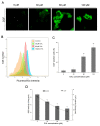Unravelling the Polytoxicology of Chlorfenapyr on Non-Target HepG2 Cells: The Involvement of Mitochondria-Mediated Programmed Cell Death and DNA Damage
- PMID: 36080487
- PMCID: PMC9457613
- DOI: 10.3390/molecules27175722
Unravelling the Polytoxicology of Chlorfenapyr on Non-Target HepG2 Cells: The Involvement of Mitochondria-Mediated Programmed Cell Death and DNA Damage
Abstract
Chlorfenapyr (CHL) is a type of insecticide with a wide range of insecticidal activities and unique targets. The extensive use of pesticides has caused an increase in potential risks to the environment and human health. However, the potential toxicity of CHL and its mechanisms of action on humans remain unclear. Therefore, human liver cells (HepG2) were used to investigate the cytotoxic effect and mechanism of toxicity of CHL at the cellular level. The results showed that CHL induced cellular toxicity in HepG2 cells and induced mitochondrial damage associated with reactive oxygen species (ROS) accumulation and mitochondrial calcium overload, ultimately leading to apoptosis and autophagy in HepG2 cells. Typical apoptotic changes occurred, including a decline in the mitochondrial membrane potential, the promotion of Bax/Bcl-2 expression causing the release of cyt-c into the cytosol, the activation of cas-9/-3, and the cleavage of PARP. The autophagic effects included the formation of autophagic vacuoles, accumulation of Beclin-1, transformation of LC3-II, and downregulation of p62. Additionally, DNA damage and cell cycle arrest were detected in CHL-treated cells. These results show that CHL induced cytotoxicity associated with mitochondria-mediated programmed cell death (PCD) and DNA damage in HepG2 cells.
Keywords: Chlorfenapyr; DNA damage; HepG2 cells; apoptosis; autophagy; cell cycle.
Conflict of interest statement
The authors declare that they have no conflict of interest.
Figures








Similar articles
-
Insecticide chlorfenapyr confers induced toxicity in human cells through mitochondria-dependent pathways of apoptosis.Ecotoxicol Environ Saf. 2025 Jan 1;289:117502. doi: 10.1016/j.ecoenv.2024.117502. Epub 2024 Dec 9. Ecotoxicol Environ Saf. 2025. PMID: 39657379
-
Natural pyrethrins induces apoptosis in human hepatocyte cells via Bax- and Bcl-2-mediated mitochondrial pathway.Chem Biol Interact. 2017 Jan 25;262:38-45. doi: 10.1016/j.cbi.2016.12.006. Epub 2016 Dec 9. Chem Biol Interact. 2017. PMID: 27939866
-
Reactive oxygen species generation and mitochondrial dysfunction for the initiation of apoptotic cell death in human hepatocellular carcinoma HepG2 cells by a cyclic dipeptide Cyclo(-Pro-Tyr).Mol Biol Rep. 2020 May;47(5):3347-3359. doi: 10.1007/s11033-020-05407-5. Epub 2020 Apr 4. Mol Biol Rep. 2020. PMID: 32248385
-
Heat Killed Attenuated Leishmania Induces Apoptosis of HepG2 Cells Through ROS Mediated p53 Dependent Mitochondrial Pathway.Cell Physiol Biochem. 2016;38(4):1303-18. doi: 10.1159/000443125. Epub 2016 Mar 24. Cell Physiol Biochem. 2016. PMID: 27010918
-
Mitochondrial ROS generation for regulation of autophagic pathways in cancer.Biochem Biophys Res Commun. 2011 Oct 14;414(1):5-8. doi: 10.1016/j.bbrc.2011.09.046. Epub 2011 Sep 17. Biochem Biophys Res Commun. 2011. PMID: 21951851 Review.
Cited by
-
Mitochondria-Mediated Apoptosis and Autophagy Participate in Buprofezin-Induced Toxic Effects in Non-Target A549 Cells.Toxics. 2022 Sep 21;10(10):551. doi: 10.3390/toxics10100551. Toxics. 2022. PMID: 36287832 Free PMC article.
-
Insect Cell-Based Models: Cell Line Establishment and Application in Insecticide Screening and Toxicology Research.Insects. 2023 Jan 18;14(2):104. doi: 10.3390/insects14020104. Insects. 2023. PMID: 36835673 Free PMC article. Review.
-
Residual Behavior and Dietary Risk Assessment of Chlorfenapyr and Its Metabolites in Radish.Molecules. 2023 Jan 6;28(2):580. doi: 10.3390/molecules28020580. Molecules. 2023. PMID: 36677638 Free PMC article.
-
A Comprehensive Review of the Current Knowledge of Chlorfenapyr: Synthesis, Mode of Action, Resistance, and Environmental Toxicology.Molecules. 2023 Nov 20;28(22):7673. doi: 10.3390/molecules28227673. Molecules. 2023. PMID: 38005396 Free PMC article. Review.
-
Delayed death of a child from chlorfenapyr poisoning: A case report and literature review.Clin Case Rep. 2024 Mar 5;12(3):e8589. doi: 10.1002/ccr3.8589. eCollection 2024 Mar. Clin Case Rep. 2024. PMID: 38449897 Free PMC article.
References
MeSH terms
Substances
LinkOut - more resources
Full Text Sources
Research Materials

